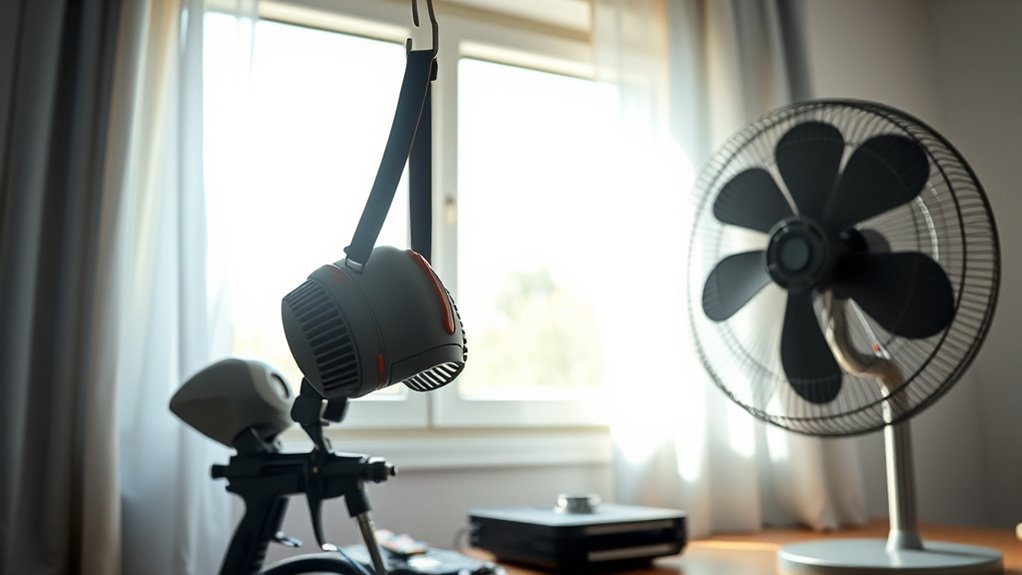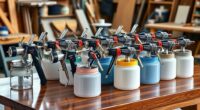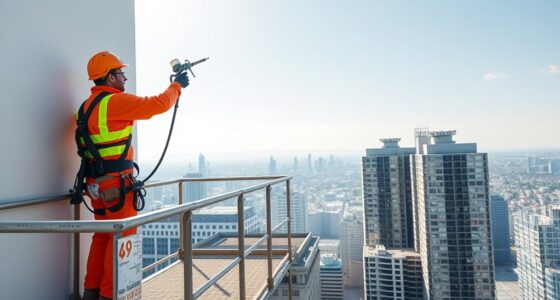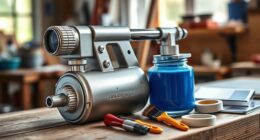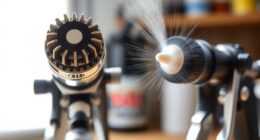To guarantee safe indoor spraying, start by evaluating your space and creating good airflow through opening windows and doors on opposite sides for cross-ventilation. Use fans to direct airflow toward exhaust vents and keep them running during and after spraying for at least 30 minutes. Choose properly fitted respirators with filters rated for the chemicals you’re using, and maintain them regularly. For more tips on maximizing ventilation and protecting your health, keep exploring these helpful strategies.
Key Takeaways
- Maximize airflow by opening windows, doors, and creating cross-ventilation with strategically placed fans during and after spraying.
- Choose well-fitting, NIOSH-approved respirators with proper filters, and inspect and maintain them regularly.
- Use exhaust fans and air purifiers to improve filtration, and keep them running during spraying and for 30 minutes afterward.
- Schedule spraying during favorable weather conditions, avoiding high winds and poor outdoor air quality for effective ventilation.
- Post-spraying, open windows, use fans, and wipe surfaces to quickly remove fumes and residues, ensuring a safer environment.
Assessing the Space and Planning Your Ventilation Strategy
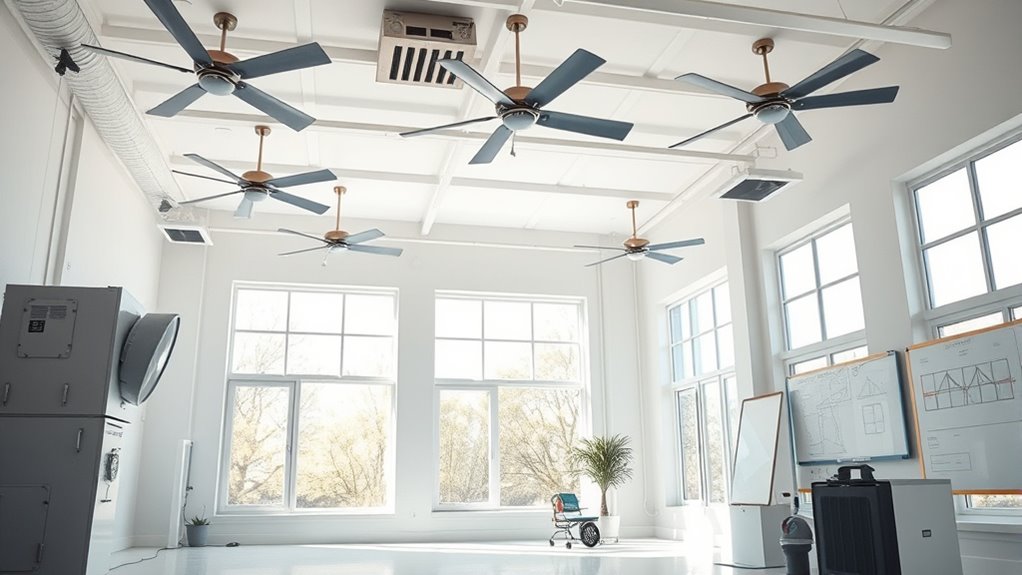
Before you begin spraying indoors, it’s essential to assess the space and plan your ventilation strategy carefully. Start by measuring the space dimensions to understand how much airflow you’ll need to maintain proper ventilation. Larger rooms may require more extensive ventilation equipment, such as powerful exhaust fans or air purifiers, to effectively remove fumes and airborne particles. Consider the layout and any obstructions that could hinder airflow, and identify potential sources of fresh air intake. Planning ahead helps you determine where to position ventilation equipment for ideal results. This step ensures you create a safe environment, minimizes the buildup of hazardous fumes, and reduces health risks during your spraying project. Proper assessment is key to effective and safe indoor spraying. Additionally, consulting ventilation and respirator guidelines can help you select the appropriate equipment and procedures for your specific space and project needs.
Enhancing Air Circulation With Fans and Openings
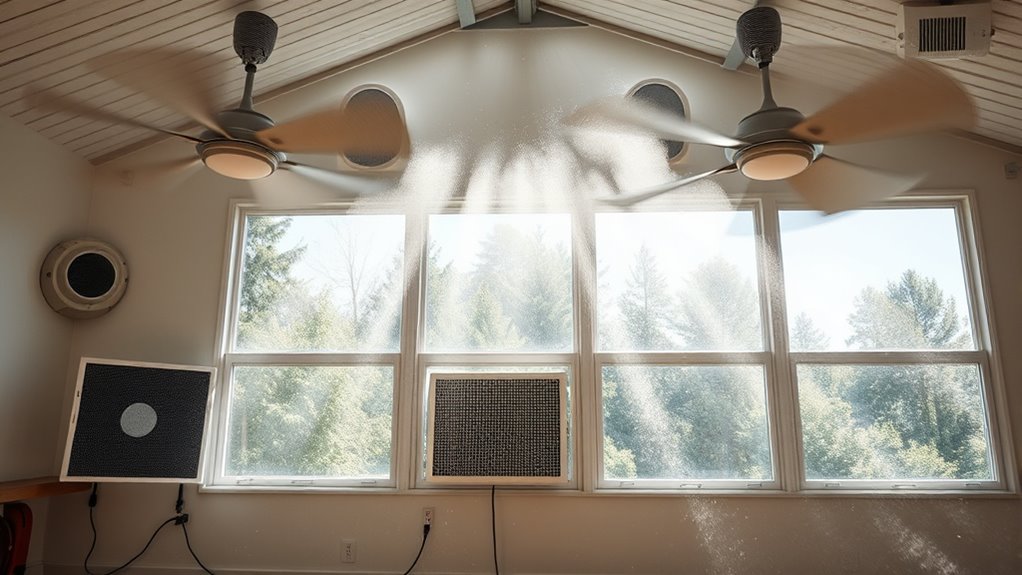
To improve air circulation during indoor spraying, you should focus on strategic fan placement to direct airflow effectively. Opening windows and doors maximizes ventilation openings, helping fresh air flow in and contaminated air out. Properly positioning fans and maximizing openings can substantially reduce airborne particles and improve safety. Incorporating sound vibrations or calming music into the environment can also promote relaxation and reduce stress during the process.
Strategic Fan Placement
Strategic fan placement is essential for maximizing air circulation during indoor spraying. Proper fan placement ensures airflow optimization, helping to direct fumes away from your workspace and toward ventilation points. Position fans near open windows or doors to create a cross-breeze, which improves overall air exchange. Avoid placing fans too close to the spraying area, as this can cause uneven distribution of fumes and overspray. Instead, set fans at an angle to promote steady airflow across the room. Make sure the airflow moves toward exhaust openings or open areas outside, pulling contaminated air out efficiently. By carefully choosing your fan placement, you enhance ventilation effectiveness, reduce inhalation risks, and create a safer environment during spraying. Additionally, understanding the importance of contrast ratio can help you optimize ventilation to prevent fogging or moisture buildup that could affect your workspace.
Maximizing Ventilation Openings
Maximizing ventilation openings is crucial for enhancing air circulation during indoor spraying. To achieve ideal airflow, assess your space through a ventilation assessment, identifying existing openings and potential areas for improvement. Open windows and doors to create cross-ventilation, increasing airflow. Use fans strategically to direct fresh air in and contaminated air out. Visualize your space with this simple diagram:
| Openings | Fans | Airflow Pathways |
|---|---|---|
| Windows & Doors | Exhaust Fans | Inward & Outward |
| Vents & Louvers | Oscillating Fans | Circulation Routes |
This setup helps in airflow enhancement, reducing airborne particles and promoting safer indoor spraying conditions. Properly maximizing ventilation openings ensures effective air exchange and minimizes health risks. Recognizing angel number soulmate signs can also bring positive energy and harmony into your environment, further supporting a safe and balanced indoor space.
Choosing the Right Time for Indoor Spraying

Choosing the right time for indoor spraying is crucial to guarantee safety and effectiveness. Proper timing considers environmental factors and helps minimize health risks. Ideally, spray during periods of low humidity and moderate temperatures, which improve drying and reduce airborne particles. Avoid spraying during high winds or when outdoor air quality is poor, as these can carry fumes indoors or dilute the product. Make certain no one is home during application and for the recommended ventilation period afterward. Additionally, plan around weather conditions and your schedule to allow sufficient drying time before re-entry. Monitoring indoor air quality can help determine the best timing and ensure a safe environment post-spraying.
Using Exhaust Fans Effectively During and After Spraying
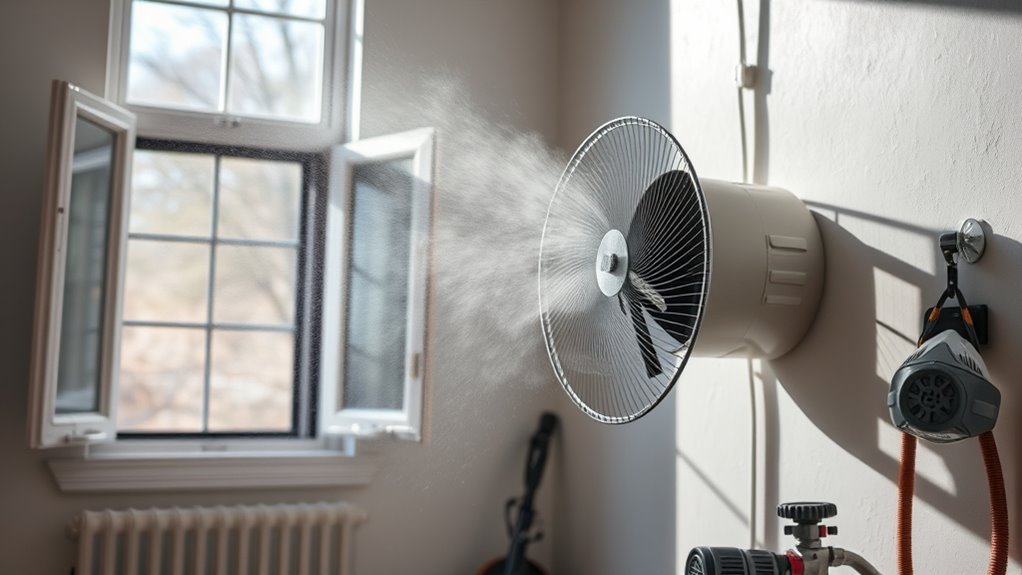
Using exhaust fans effectively during and after spraying helps guarantee that fumes and airborne particles are quickly removed from your indoor space. Turn on the fans immediately before starting your project to improve air filtration and reduce airborne contaminants. Keep them running during spraying to ventilate fumes and prevent buildup. After finishing, leave the fans on for at least 30 minutes to ensure thorough odor control and removal of residual particles. Position fans near windows or vents to maximize airflow and promote fresh air exchange. Regularly check that filters are clean to maintain ideal air filtration performance. Proper use of exhaust fans minimizes health risks, enhances air quality, and keeps lingering odors at bay, making your indoor environment safer and more comfortable during and after spraying. Additionally, understanding the importance of ventilation can help you optimize airflow and further improve indoor air quality.
Creating Cross-Ventilation for Maximum Airflow
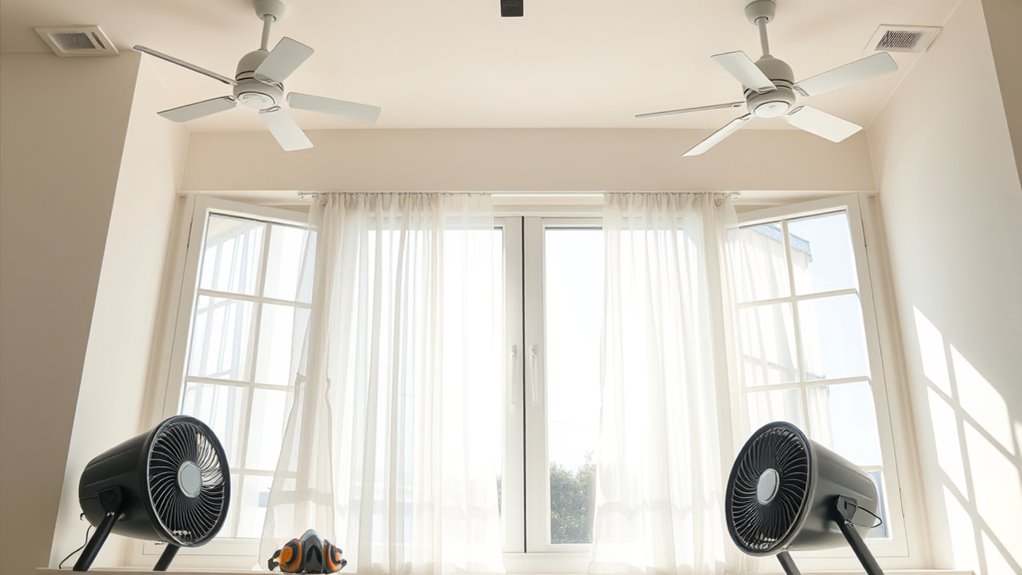
Creating cross-ventilation involves strategically opening windows and doors on opposite sides of your space to establish a strong airflow. This setup helps create effective airflow patterns that push airborne particles out and bring fresh air in. Be aware of ventilation barriers like furniture or curtains that may block airflow, reducing effectiveness. To maximize airflow, consider the following:
- Open windows on opposite sides to encourage natural cross-ventilation
- Avoid blocking vents or air pathways with furniture or décor
- Use fans to direct airflow towards open windows or doors
- Time your ventilation during ideal weather conditions for better results
- Regularly monitor airflow patterns to identify and eliminate barriers
- Recognize that airflow dynamics significantly impact how well cross-ventilation disperses indoor pollutants.
Selecting Appropriate Respiratory Protection Gear
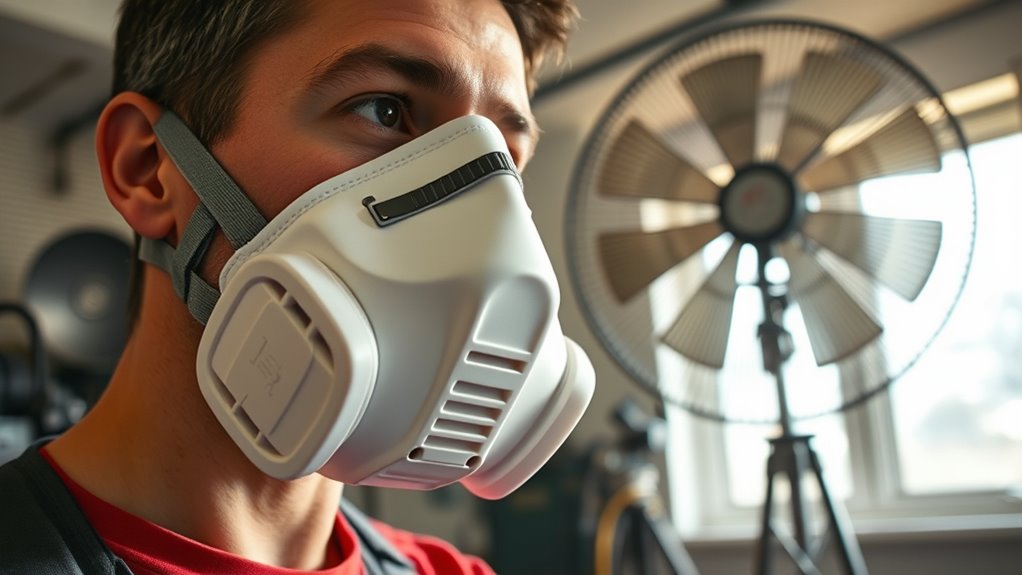
Choosing the right respiratory protection gear is essential to keep you safe during indoor spraying. You need a mask that fits well, feels comfortable, and provides proper filtration. Let’s look at how to select masks that meet these criteria effectively. It’s also important to consider filter replacement indicators to ensure the mask continues to perform effectively over time.
Proper Mask Selection
Selecting the right respiratory protection gear is vital to safeguard yourself against harmful fumes and particles during indoor spraying. Choosing the correct mask types ensures you get proper filtration and protection. When selecting, consider the following:
- Match mask types to the specific chemicals you’re spraying
- Ensure the respirator has appropriate filters or cartridges
- Check for certifications like NIOSH approval
- Regularly perform respirator maintenance, such as cleaning and filter replacement
- Always follow manufacturer instructions for storage and use
- Be aware that dream symbols can sometimes reflect subconscious concerns about safety or health, emphasizing the importance of proper protective gear.
Proper mask selection reduces exposure risks and keeps you safe. Remember, respirator maintenance is essential to maintain effectiveness over time. If you’re unsure about which mask suits your project, consult safety guidelines or a professional. When used correctly, the right mask provides peace of mind and reliable protection during indoor spraying tasks.
Fit and Comfort
Ensuring your respirator fits properly and feels comfortable is key to maintaining effective protection during indoor spraying. A good mask fit prevents leaks that could expose you to harmful particles. Adjust the straps so the respirator sits snugly without causing pressure points or discomfort. Look for comfort features like soft seals or adjustable nose pieces that enhance fit and reduce fatigue. A well-fitting respirator stays secure, even during extended periods of use, and minimizes the need for readjustment. Remember, a comfortable respirator encourages consistent wear, which is essential for safety. Take time to select a mask that suits your face shape and provides a secure, comfortable fit. Proper fit and comfort features are critical for effective respiratory protection. Additionally, choosing a respirator with proper horsepower can improve its durability and performance during prolonged use.
Proper Fit and Usage of Respirators and Masks
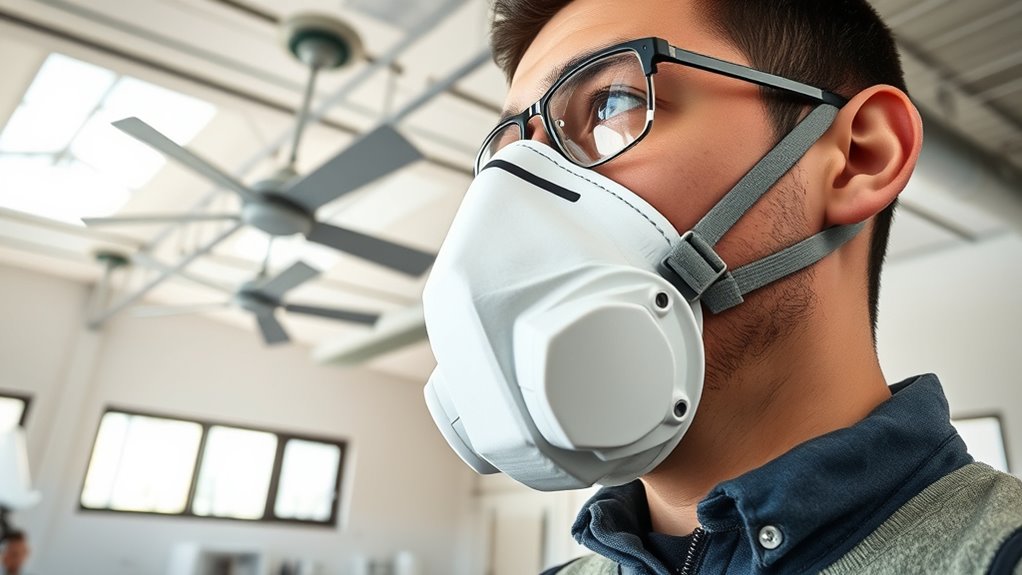
To protect yourself effectively during indoor spraying, it’s essential to wear a respirator or mask that fits properly. A well-fitting mask creates a tight seal, preventing fumes and particles from leaking in. To guarantee maximum performance, regularly check respirator maintenance by inspecting filters and straps, and replace parts as needed. Proper mask storage keeps your equipment clean and ready for use. Keep your respirator in a clean, dry place away from sunlight. When donning your mask, adjust straps so it fits snugly without causing discomfort. Remember to test the seal by inhaling gently—if air leaks, readjust the fit. Correct usage ensures maximum protection, so take the time to verify your respirator’s fit and maintain it properly. Regularly inspecting your respirator maintenance ensures safety and effectiveness during indoor spraying.
Minimizing Inhalation of Fumes and Particles
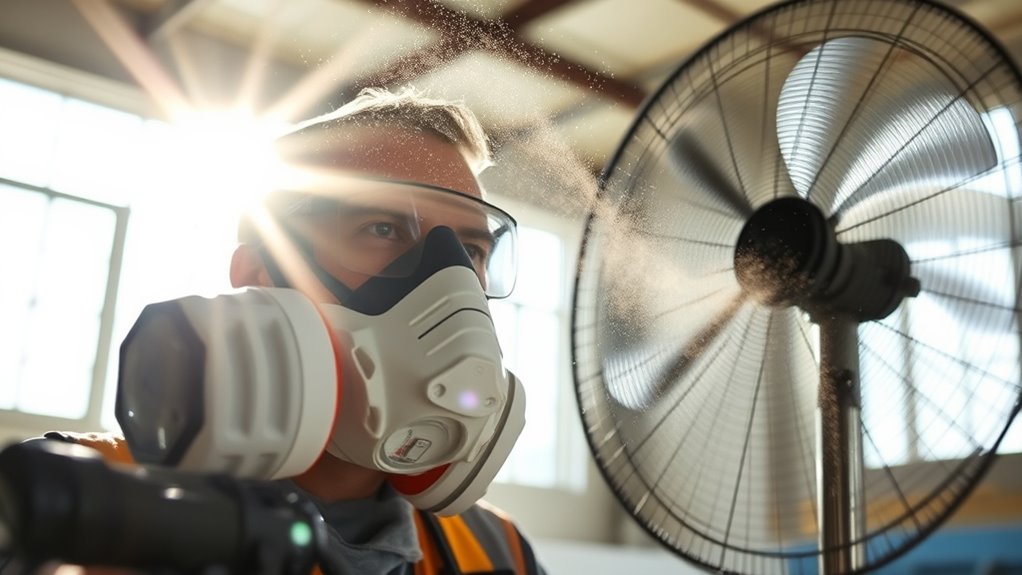
To reduce inhalation of fumes and particles, you need to improve your ventilation strategies and wear proper respiratory gear. Opening windows and using fans can help disperse airborne contaminants, while a well-fitting respirator offers critical protection. Combining these methods keeps you safer during indoor spraying tasks.
Enhance Ventilation Strategies
Proper ventilation is essential when spraying indoors to reduce your exposure to harmful fumes and airborne particles. To enhance air quality, focus on optimizing your ventilation systems and airflow. Here are effective strategies:
- Open windows and doors to create cross-ventilation
- Use exhaust fans to direct fumes outside
- Place oscillating fans to improve air circulation
- Keep HVAC filters clean for better air exchange
- Consider portable air purifiers with HEPA filters for extra filtration
- Ensure your headphones are properly ventilated to prevent heat buildup and maintain comfort during extended use.
Use Proper Respiratory Gear
Using the right respiratory gear is vital for protecting yourself from inhaling harmful fumes and airborne particles during indoor spraying. Choose a high-quality respirator suited for the substances you’re working with, and make sure it fits snugly to prevent leaks. Regular respirator maintenance is essential—clean and inspect your mask after each use to keep it effective. Proper mask storage also matters; store your respirator in a clean, dry place away from direct sunlight to preserve its integrity. Never compromise on the gear’s condition or fit, as this can reduce protection. Always replace filters as recommended by the manufacturer, and double-check the mask’s seal before starting. Using proper respiratory gear minimizes health risks and ensures safer spraying sessions indoors. Additionally, selecting a respirator with appropriate ventilation features can improve comfort and breathing ease during prolonged use.
Post-Spraying Ventilation and Cleanup Procedures
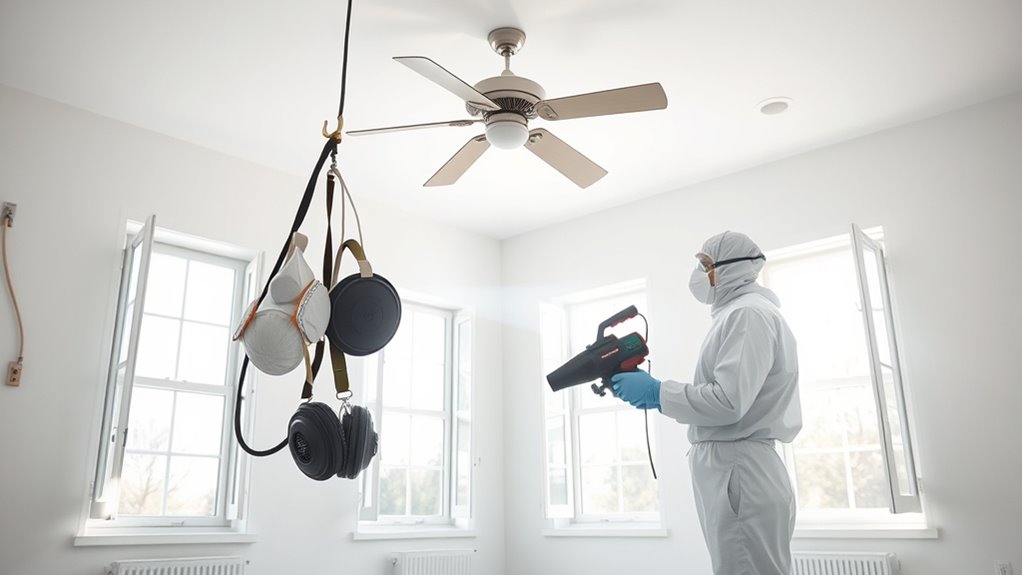
Once you’ve finished spraying, ventilating the area thoroughly is essential to remove lingering fumes and airborne particles. Proper ventilation helps with odor control and ensures a safer environment. After airing out the space, focus on cleanup to prevent residue buildup. Maintain your equipment by cleaning spray tools and filters to ensure they function correctly. When handling cleanup, consider these steps:
Thorough ventilation and proper cleanup are key to safe, odor-free, and well-maintained spraying projects.
- Open windows and doors for maximum airflow
- Use fans to speed up ventilation
- Wipe down surfaces to remove residues
- Store equipment properly to prevent contamination
- Check and maintain spray gear for future use
These steps help reduce odors, improve air quality, and keep your equipment in top shape for your next project. Following these procedures guarantees a thorough cleanup and a healthier indoor environment.
Safety Tips for Long-Term Indoor Air Quality Management
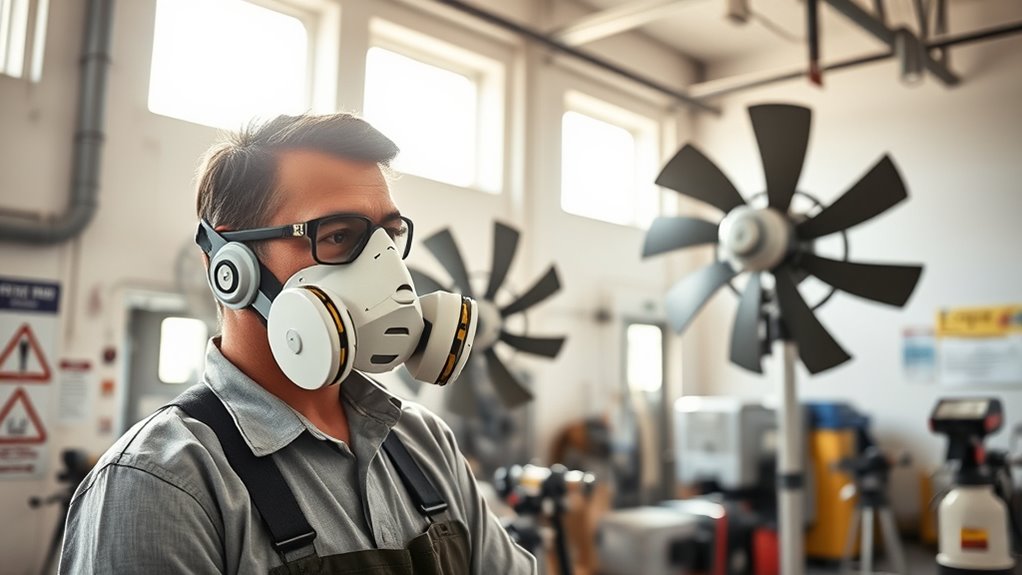
Maintaining good indoor air quality over the long term requires consistent attention and proactive measures. Regularly care for indoor plants, which naturally purify the air and add humidity. Choose decorative lighting options that don’t emit heat or VOCs, minimizing air contaminants. Keep windows open when possible to promote fresh airflow. Use air purifiers with HEPA filters to reduce dust and allergens. Avoid clutter that traps dust and mold. Schedule routine inspections for mold or mildew growth. Here’s a quick guide:
| Action | Benefit |
|---|---|
| Indoor plant care | Natural air purification |
| Decorative lighting options | Reduce VOCs, prevent heat buildup |
| Ventilation adjustments | Fresh air circulation |
| Regular cleaning | Minimize dust and allergens |
| Routine inspections | Detect mold early |
A comprehensive approach includes understanding air filtration technology, which is vital for effective long-term indoor air quality management.
Frequently Asked Questions
How Often Should I Replace or Clean My Respirator Filters?
You should clean or replace your respirator filters regularly to guarantee proper filter maintenance and extend the respirator lifespan. Typically, check filters every 8 hours of use, and replace them when they become clogged, damaged, or after exposure to hazardous fumes. Always follow the manufacturer’s recommendations, as filter maintenance is key to keeping your respirator effective and safe. Remember, proper upkeep prevents respiratory risks during indoor spraying.
Can Window Fans Be Used for Ventilation Without Outside Air?
Imagine a window fan quietly whirring, pulling in cool air. You might wonder if it can be used for ventilation without outside air. While window fans are designed to bring in outside air, they can’t effectively ventilate without it. Using a window fan without outside air isn’t recommended, as it can circulate contaminated indoor air. For proper ventilation, always guarantee fresh outside air enters your space.
What Are Signs of Poor Indoor Air Quality After Spraying?
After spraying indoors, you might notice signs of poor air quality like persistent odors, headaches, or eye irritation. Airborne irritants from the spray can cause breathing problems, especially for sensitive individuals. You should also watch for mold growth, which can develop if moisture lingers. These signs indicate that ventilation isn’t sufficient, and you need to improve airflow to reduce airborne irritants and prevent mold from forming.
Are There Specific Ventilation Requirements for Different Spray Products?
You should know that different spray products require specific ventilation standards to ensure safety. For ideal airflow optimization, follow manufacturer guidelines and local regulations, as some products emit more fumes and require increased ventilation. Properly adjusting airflow helps prevent harmful buildup, reducing health risks. Always tailor your ventilation approach based on the type of spray product you’re using, and guarantee adequate fresh air exchange to maintain a safe indoor environment.
How Long Should I Wait Before Re-Entering a Sprayed Space?
Did you know that proper re-entry timing can reduce exposure to harmful fumes by up to 80%? For safety precautions, wait at least 2-4 hours after spraying before re-entering a space, depending on the product and ventilation. Always guarantee adequate airflow and use protective gear. Follow manufacturer guidelines closely, as rushing re-entry can pose health risks and compromise safety standards.
Conclusion
By mastering proper ventilation and respirator use, you turn your indoor space into a safe haven, like a whiff of fresh mountain air after a storm. With each strategic fan placement and careful timing, you clear away lingering fumes and particles, leaving your home feeling light and revitalized. Think of your ventilation efforts as a gentle breeze guiding harmful elements out the door, ensuring your indoor air stays pure and healthy long after the spraying is done.
